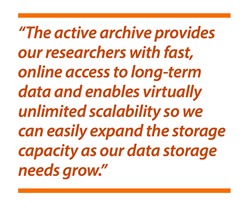HiPACC Data Science Press Room. From: AMES
The Data Science Press Room highlights computational and data science news in all fields *outside of astronomy* in the UC campuses and DOE laboratories comprising the UC-HiPACC consortium. The wording of the short summaries on this page is based on wording in the individual releases or on the summaries on the press release page of the original source. Images are also from the original sources except as stated. Press releases below appear in reverse chronological order (most recent first).
October 28, 2014 — NASA’s Pleiades supercomputer upgraded, gets one petaflops boost
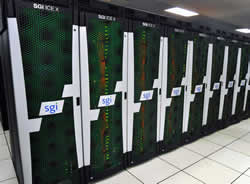
The addition of SGI ICE X racks containing Intel Xeon Ivy Bridge and Haswell processors in 2014 increased Pleiades' theoretical peak processing power from 2.88 petaflops to 4.5 petaflops.
NASA Ames 10/28/2014—NASA’s flagship supercomputer, Pleiades, was recently upgraded with new, more powerful hardware in order to help meet the space agency’s increasing demand for high-performance computing resources. Completed in October 2014, the upgrade adds 15 SGI ICE X racks (1,080 nodes) containing the latest generation of 12-core Intel Xeon E5-2680v3 (Haswell) processors. Additionally, 216 nodes of Intel Xeon E5-2680v2 (Ivy Bridge) processors, originally part of a separate test system, were also integrated into Pleiades. The new hardware increased Pleiades' theoretical peak performance to more than 4.49 petaflops (quadrillion floating-point operations per second), a one petaflops increase from the previous configuration.
View AMES Data Science Press Release
October 21, 2014 — NAS Hyperwall visualization system upgraded with Ivy Bridge nodes
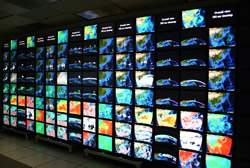
The hyperwall’s 128 nodes are connected to a 128-screen tiled LCD wall at the NAS facility, arranged in an 8x16 configuration measuring 23-ft. wide by 10-ft. high. The nodes can display, process, and share data among themselves, allowing the system to display a single image across all the screens or to display configurations of data in “cells.” Credit: NASA/Ames
NASA Ames 10/21/2014—The hyperwall at the NASA Advanced Supercomputing (NAS) Division at NASA Ames Research Center is one of the largest and most powerful visualization systems in the world, providing a supercomputer-scale environment for NASA researchers to display and analyze high-dimensional datasets in a multitude of ways. And it just got better. Systems and visualization engineers increased the hyperwall’s peak processing power from 9 to 57 teraflops, quadrupled the amount of memory, and nearly tripled the interconnect bandwidth, while simultaneously decreasing the system's physical footprint and overall power consumption. This improved visualization capability will enable more detailed analysis of simulation results produced on the NAS facility's supercomputers, enhancing the ability of scientists and engineers to gain greater insight from their research. It will also help meet the challenges associated with analyzing the growing archive of high-resolution observational data gathered from NASA instruments such as telescopes, Earth-observing satellites, and planetary rovers.
View AMES Data Science Press Release
October 3, 2014 — Research opportunity announced for Quantum Artificial Intelligence Laboratory
NASA Ames 10/3/2014—The Universities Space Research Association (USRA) has announced a call for proposals to utilize the D-Wave Two quantum computer at NASA’s Quantum Artificial Intelligence Laboratory, located at the NASA Advanced Supercomputing facility at NASA Ames Research Center. The projects selected will have access to the computer from November 2014 through September 2015 in order to research artificial intelligence algorithms and advanced programming techniques for quantum annealing. The deadline for proposals is October 31, 2014.
NASA Ames link goes to USRA:
http://www.usra.edu/quantum/rfp/
August 22, 2014 — NASA picks top Earth data challenge ideas, opens call for climate apps
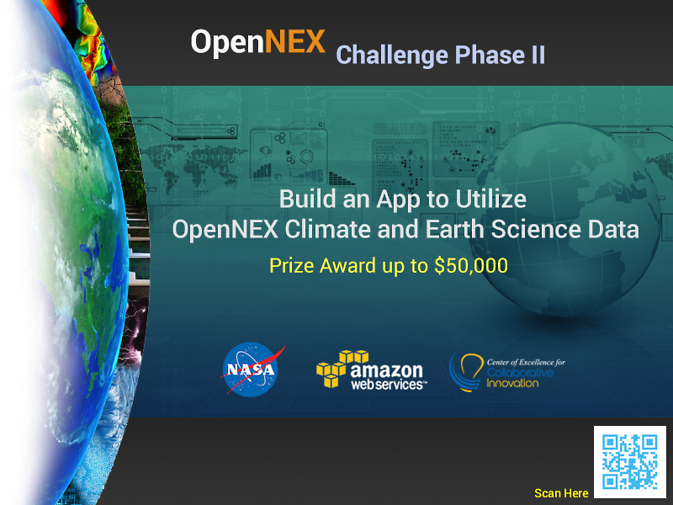
OpenNEX Challenge Phase II. Credit: NASA
NASA Ames 8/22/2014—NASA has selected four ideas from the public for innovative uses of climate projections and Earth-observing satellite data. The agency also has announced a follow-on challenge with awards of $50,000 to build climate applications based on OpenNEX data on the Amazon cloud computing platform. Both challenges use the Open NASA Earth Exchange, or OpenNEX, a data, cloud computing, and knowledge platform where users can share modeling and analysis codes, scientific results, information and expertise to solve big data challenges in the Earth sciences. OpenNEX provides users a large collection of climate and Earth science satellite data sets, including global land surface images, vegetation conditions, climate observations and climate projections.
View AMES Data Science Press Release
June 24, 2014 — NASA launches earth science challenges with OpenNEX cloud data
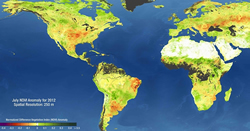
NASA satellite data incorporated into OpenNEX include global views of drought conditions. Green regions in this map of July 2012 are areas with more vegetation than an average July (2000–2013); red regions have less vegetation than average. Regions in black have no data due to clouds and snow. Credit: NASA Earth Exchange (NEX)
NASA Ames 6/24/14—NASA is launching two challenges to give the public an opportunity to create innovative ways to use data from the agency’s Earth science satellites. The challenges will use the Open NASA Earth Exchange (OpenNEX)—a data, supercomputing, and knowledge platform where users can share modeling and analysis codes, scientific results, and expertise—to solve big data challenges in the Earth sciences. A component of the NASA Earth Exchange, OpenNEX provides users a large collection of climate and Earth science satellite data sets, including global land surface images, vegetation conditions, climate observations and climate projections. The two challenges will allow citizen scientists to realize the value of NASA data assets and to offer NASA new ideas on how to share and use that data. The first “ideation” stage of the challenge, which runs July 1 through August 1, offers up to $10,000 in awards for ideas on novel uses of the datasets. The second “builder” stage, beginning in August, will offer between $30,000 and $50,000 in awards for the development of an application or algorithm that promotes climate resilience using the OpenNEX data, based on ideas from the first stage of the challenge. NASA will announce the overall challenge winners in December.
View AMES Data Science Press Release
June 2, 2014 — Case study: NAS tape-based solution to manage and store high-volume data
NASA Ames 6/2/14—This case study on the mass storage and archiving systems at the NASA Advanced Supercomputing (NAS) facility at NASA Ames Research Center looks specifically at NAS’s automated method of archiving data from disk to tape, which saves energy and space while still making data easily accessible to users—forever. The Active Archive Alliance is a collaborative industry organization that explores new technologies for enabling reliable, online, and efficient access to archived data.
View AMES Data Science Press Release
April 22, 2014 — Why Earth matters to NASA: A conversation with Harrison Ford

Harrison Ford (right) gets a close-up look at NASA research on deforestation and other global forest cover changes at Ames Research Center.
NASA Ames 4/22/14 — Actor Harrison Ford was on location at NASA’s Ames Research Center, Moffett Field, Calif., last November to film a segment of Showtime’s Years of Living Dangerously documentary on climate change. Ford toured the NASA Advanced Supercomputing (NAS) facility where he met with scientists Rama Nemani of Ames and Matthew Hansen of the University of Maryland, College Park, to learn more about how NASA satellite data, research, and technologies are used around the world to better understand and protect Earth. Analyzing massive datasets like global forest change cover over time is a unique capability of NASA’s Earth Exchange (NEX), a project based at NAS led by Nemani. NEX allows researchers to share knowledge, research, and tools to address global environmental challenges.
View AMES Data Science Press Release
April 1, 2014 — April 1, 2014 — New applied modeling and simulation seminar video archive
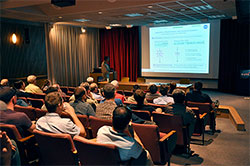
he NASA Advanced Supercomputing facility seminar series are recorded for on-demand playback on the web.
NASA Ames 4/1/14 — Hosted by the Applied Modeling and Simulation (AMS) Branch at the NASA Advanced Supercomputing facility, the NAS Applied Modeling and Simulation (AMS) seminar series presents talks on recent achievements, innovative tools, and current problems being faced by members of the modeling and simulation community from NASA, government, industry, and academia. Typically held weekly, the seminars are recorded for on-demand playback on the web in the AMS seminar archive, where visitors can view videos, abstracts and speaker biographies from recent seminars; find announcements of upcoming talks; and search a new archive of past seminar topics. More at
http://www.nas.nasa.gov/publications/ams/ams.html.




